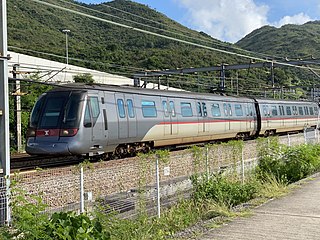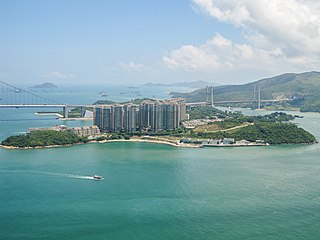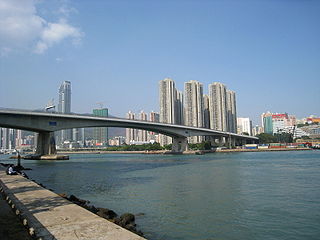
Tsing Ma Bridge is a bridge in Hong Kong. It is the world's 16th-longest span suspension bridge, and was the second longest at the time of its completion. The bridge was named after the two islands it connects, namely Tsing Yi and Ma Wan. It has two decks and carries both road and rail traffic, which also makes it the largest suspension bridge of this type. The bridge has a main span of 1,377 metres (4,518 ft) and a height of 206 metres (676 ft). The span is the longest of all bridges in the world carrying rail traffic.

Tung Chung, meaning "eastern stream", is an area on the northwestern coast of Lantau Island, Hong Kong. One of the most recent new towns, it was formerly a rural fishing village beside Tung Chung Bay, and along the delta and lower courses of Tung Chung River and Ma Wan Chung in the north-western coast of Lantau Island. The area was once an important defence stronghold against pirates and foreign military during the Ming and the Qing dynasties.

The Tung Chung line is one of the ten lines of the MTR system in Hong Kong, linking the town of Tung Chung with central Hong Kong. It was built in the 1990s as part of the Airport Railway project, part of the construction of the new Chek Lap Kok Airport. The line currently travels through eight stations in 31 minutes along its route. The line is coloured orange on the MTR system map.

Ma Wan is an island of Hong Kong, located between Lantau Island and Tsing Yi Island, with an area of 0.97 square kilometres. Administratively, it is part of Tsuen Wan District.

The Lantau Link, formerly known as the Lantau Fixed Crossing, is a roadway in Hong Kong forming part of Route 8 linking Lantau Island to Tsing Yi, from which other roads lead to the urban areas of Kowloon and the rest of the New Territories. Part of the Airport Core Programme centred on the new Hong Kong International Airport on Lantau. The link was officially opened on 27 April 1997, and it opened to traffic on 22 May the same year.

Ting Kau Bridge is a 1,177-metre (3,862 ft) long cable-stayed bridge in Hong Kong that spans from the northwest of Tsing Yi Island and Tuen Mun Road. It is near the Tsing Ma Bridge which also serves as a major connector between the Hong Kong International Airport on Lantau Island and the rest of Hong Kong. It was completed on 5 May 1998. The bridge is toll-free.

Route 8 of Hong Kong is a dual 3-lane carriageway motorway that links Lantau Island, Tsing Yi Island, Cheung Sha Wan in West Kowloon, and Sha Tin in the southeast New Territories of Hong Kong. It is a combination of many sections.

The Kap Shui Mun Bridge (KSMB) in Hong Kong, part of Lantau Link of Route 8, is one of the longest cable-stayed bridges in the world that transports both road and railway traffic, with the upper deck used for motor vehicles and the lower deck for both vehicles and the MTR. It has a main span of 430 metres (1,410 ft) and an overall length of 750 metres (2,460 ft). It spans the Kap Shui Mun marine channel between Ma Wan and Lantau islands and has a vertical clearance of 47 metres (154 ft) above sea level. The bridge was completed in 1997.

Tsing Yi North Bridge, also called Tsing Tsuen Bridge (青荃橋), connects the Tam Kon Shan Interchange on Tsing Yi Island to the Tsuen Tsing Interchange in Tsuen Wan, spanning the Rambler Channel. Inaugurated on 10 December 1987, the bridge was designed to improve access to Tsing Yi, which at that time was connected to Kwai Chung by only one fixed link, the heavily congested Tsing Yi Bridge.

Stonecutters Bridge is a high level cable-stayed bridge spanning the Rambler Channel in Hong Kong, connecting Nam Wan Kok, Tsing Yi to Stonecutters Island. The bridge deck was completed on 7 April 2009, and opened to traffic on 20 December that year. The bridge was the second-longest cable-stayed span in the world at the time of its completion.

The Airport Core Programme was a series of infrastructure projects centred on the new Hong Kong International Airport during the early 1990s. The programme was part of the Port and Airport Development Strategy, commonly known as the Rose Garden Project.

Kap Shui Mun or Throat Gates is the channel between Lantau Island and Ma Wan in Hong Kong. It is part of major sea route along the coast of South China, from Victoria Harbour to the Pearl River. It joins north with Urmston Road. Kap Shui Mun Bridge, part of Route 8, spans the channel.

North Lantau Highway is an expressway forming part of Hong Kong's Route 8, linking Hong Kong International Airport and Lantau Island with the rest of the territory. The road has three lanes in each direction for its entire length with full-width hard shoulders for emergencies and breakdowns. The speed limit is 110 kilometres per hour (68 mph) for most of its length, the highest of any road in Hong Kong.

The Airport Core Programme Exhibition Centre is housed in a single-storey distinctive white structure situated at 401 Castle Peak Road, Ting Kau, New Territories in Hong Kong. The exhibition centre is run by the Home Affairs Department for the Airport Core Programme, often referred to as the Rose Garden Project.

Tsing Ma Control Area is an area covering Lantau Link and related road networks in the New Territories, Hong Kong, including Tsing Ma Bridge, Kap Shui Mun Bridge, Ma Wan Viaduct, Cheung Tsing Highway, Cheung Tsing Tunnel, Cheung Tsing Bridge, Ting Kau Bridge, North West Tsing Yi Interchange, Tsing Kwai Highway and North Lantau Highway, but excluding the area of rails managed by the MTRCL.
Articles related to Hong Kong include:

Tsing Chau Tsai Peninsula is the peninsula located at the northeast of Lantau Island, New Territories, Hong Kong, including Yam O, To Kau Wan, Tai Tsing Chau, Tsing Chau Tsai and Penny's Bay.

The Hong Kong government started developing new towns in the 1950s to accommodate Hong Kong's booming population. During the first phase of development, the newly developed towns were called "satellite towns", a concept borrowed from the United Kingdom, of which Hong Kong was a colony. Kwun Tong, located in eastern Kowloon, and Tsuen Wan, located in the south-west of the New Territories, were designated as the first satellite towns, when the urban area in Hong Kong was still relatively small, restricted to the central and western parts of Kowloon Peninsula and the northern side of Hong Kong Island. Wah Fu Estate was also built in a remote corner on the southern side of Hong Kong Island, with similar concepts but at a smaller scale.
Tsing Lung Bridge (青龍大橋) is a proposed suspension bridge in Hong Kong, from North Lantau to Tsing Lung Tau, in the western New Territories, between Tsuen Wan and Tuen Mun, forming part of the Route 10 North Lantau to Yuen Long Highway. The bridge and highway have not been constructed. At the time of its announcement in 2002, it would have been the world's 4th-longest suspension bridge, with a main span of 1,418 metres (4,652 ft) - 41 metres longer than the Tsing Ma Bridge. Detailed planning was then complete and construction was due to commence in 2003 and be open to traffic in 2008.



















